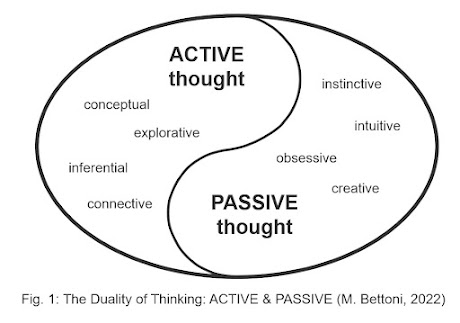In my previous post I mentioned "background thinking" as a process that brings to our mind thoughts that we did not search for or even did not want to deal with.
A friend then said: "I am a very instinctive person. What about instinct? Where is it in your model? Is it part of the background thinking?"
Good question!
HOW WE KNOW: ACTIVE & PASSIVE PROCESSES
In fact, beside instinctive, there are also other thought processes of this kind, like "intuitive", "creative" thinking. They all produce thoughts in a spontaneous way, without an active construction and control by the individual, who behaves rather passively in relation to them.
Based on this I would distinguish two main areas of thinking: ACTIVE & PASSIVE processes.
Then the flow of thought can be conceived as a continuous alternation of active and passive thought.
Active and passive thought processes form a unity in their duality, they complement each other and they also influence each other.
For example in the mantra meditation technique, actively repeating the same sentence (and related meaning) has an influece on passive thinking.
A similar example are people suffering from obsessive thoughts: in this case the mantra comes from passive thinking processes and influences the active thought processes and so on.
Last but not least advertising: even if the message is actively perceived and interpreted, the goal is to influence the passive thinking of the person so that he or she will buy the product or service "instinctively".
My "Two-Worlds" model is intended as a model of the ACTIVE processes of thinking, those that we can control directly.
A model of PASSIVE thinking will follow later, becaue it requires the ACTIVE model as a prerequisite.

No comments:
Post a Comment